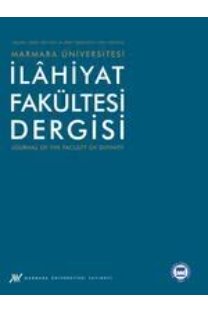Soyun Önemi Bağlamında Yahudi-Haşmoni Krallığı ve Vaftizci Yahya
Haşmoni, Seçilmiş Soy, Kohen, Herod, Vaftizci Yahya, Sanhedrin.
The Kingship Experience of Cohens in the Context of Genealogical Superiority: The Kingdom of Hasmoneans
Hasmoneans, Chosen Genealogy, Cohen, Herod the Great, John the Baptist, Sanhedrin.,
___
- Kaynaklar
- Arslantaş, Nuh, “Re’sülcâlût”, DİA, XXXV, 5-6.
- Atkinson, Kenneth, Queen Salome Jerusalem’s Warrior Monarch of the First Century B. C. E, Jefferson, North Calorina : McFarland & Co, 2012.
- The Babylonian Talmud (ed. Rabbi Epstein), London: The Soncino Press, 1978.
- Baumgarten, A. I., “The Name of the Pharisees”, Journal of Biblical Literature, 1983, CII, sy. 3, s. 411-428. ha-Bavli, Natan , Seder Olam Zuta: Dünyanın Kısa Tarihi (trc. Nuh Aslantaş), Ankara: Türk Tarih Kurumu, 2014.
- Bickerman, Elias, From Ezra to the Last of the Maccabees, New York: Shocken Books, 1949.
- Dąbrowa, Edward, The Hasmoneans and Their State, Kraków: Wydawnictwo Uniwersytetu Jagiellońskiego Wydanie, 2010.
- Encyclopedia Judaica, “Zugot”, XXI, 680.
- Eyal, Regev, The Hasmoneans Ideology, Archaeology, Identity, Göttingen: Vandenhoeck&Ruprecht, 2013.
- Finkelstein, Louis, “The Pharisees: Their Origin and Their Philosophy”, The Harvard Theological Review, 1929, XII, sy. 3, s. 185-261.
- Geiger, Abraham, Judaism and Islam (trc. F. M. Young), Vepery: M.D.C.S.P.C.K. Press, 1898.
- Ginzberg, Louis, “Alexander Jannæus (Jonathan)”, Jewish Encyclopedia, I, 352-354.
- Goldstein, Jonathan A., I Maccabees, New York: Doubleday, 1976.
- Gürkan, Salime Leyla, Yahudilik, İstanbul: İSAM, 2012.
- ------, “Vaftiz”, DİA, XLII, 424-426
- Harman, Ömer Faruk, “İmrân”, DİA, XXII, 232.
- Hendin, David, “Numismatic Expressions of Hasmonean Sovereignty”, Israel Numismatic Journal, 2007- 2008, sy. 16. s. 76-91.
- Ilan, Tal, “The Greek Names of the Hasmoneans”, The Jewish Quartely Review, 1987, LXXVIII, sy. 1-2, s. 1-20.
- ------, “Queen Salamzion Alexandra and Judas Aristobulus I’s Widow: Did Jannaeus Alexander Contract a Levirate Marriage?”, Journal for the Study of Judaism, 1993, sy. 24, s. 181-90.
- Islamic Awareness, “And No One Had The Name Yaḥya (= John?) Before: A Linguistic & Exegetical Enquiry Into Qur’an 19:7” http://www.islamic-awareness.org/Quran/Contrad/External/yahya.html (erişim tarihi: 29.05.2017).
- Joseph-Kohler: Jacobs, Joseph-Kaufmann Kohler, “Nasi”, Jewish Encyclopedia, 9, s. 171-172
- Josephus, Flavius, The Antiquties of the Jews (trc. William Whiston), http://www. perseus. tufts. edu/hopper/ text?doc=Perseus:text:1999. 01. 0146 (erişim tarihi: 29.05.2017).
- ------, The Wars of the Jews (trc. William Whiston), http://www. perseus. tufts. edu/hopper/ text?doc=Perseus:text:1999. 01. 0148 (erişim tarihi: 29.05.2017).
- Klawans, Jonathan, “Sadducees, Zadokites and the Wisdom of Ben Sira”, David B. Capes vd. , Israel’s God Rebecca’s Children, Baylor University Press, 2008, s. 261-276.
- Kohler-Krauss: Kohler, Kaufmann-Samuel Krauss , “Baptism”, Jewish Encyclopedia, II, 499-500.
- Kurt, Ali Osman, Babil Sürgünü Sonrası Ezra Önderliğinde Yahudiliğin Yeniden Yapılandırılması (doktora tezi, 2006), Ankara Üniversitesi SBE.
- Kutluay, Yaşar, İslâm ve Yahudi Mezhepleri, İstanbul: Anka Yayınları, 2001.
- Kutsal Kitap, http://www. kutsal-kitap. net (erişim tarihi: 29.05.2017).
- Küçük, Abdurrahman, “Al-i Ya‘kub”, DİA, II, 309-310.
- Lamm, Maurice, “Kohen Marriages”, chabad. org http://www. chabad. org/library/article_cdo/aid/468267/ jewish/Kohen-Marriages. htm (erişim tarihi: 29.05.2017).
- Main, Emmanuelle, “Yannai (Jannaeus) Alexander”, Encyclopedia Judaica, XXI, 282-283.
- Mansoor, Menahem, “Hassideans”, Encyclopedia Judaica, VIII, 455.
- Mantel, Hugo, “Sanhedrin”, Encyclopedia Judaica, XVIII, 21-23
- Milwitzky, William, Alexandra, Jewish Encyclopedia, I, 358-359.
- Rappaport, Uriel, “Nicanor”, Encyclopedia Judaica, XV, 247.
- ------, “Maccabean Revolt”, New Interpreter’s Dictionary of the Bible, IV, 434.
- ------, “Menelaos”, Encyclopedia Judaica, XIV, 46.
- Rosenberg, Stephen G. , “Tobiads”, Encyclopedia Judaica, XX, 9-11.
- ------, “Temple of Onians”, Encyclopedia Judaica, XV, 432-433.
- Sarıkçıoğlu, Ekrem, Diğer İnciller (Apokrif İnciller), Isparta: Fakülte Kitapevi, 2005.
- Schofield-VanderKam: Schofield, Alison-VanderKam, James C., “Were the Hasmoneans Zadokites?”, Journal of Biblical Literature, 2005, CXXIV, sy. 1, s. 73-87.
- Schürer, Emil, A History of Jewish People in the time of Jesus Christ, 3 (trc. Sophia Taylor-Rev. Peter Christe), Edinburgh: T&T Clark, 1886.
- Singer-Lauterbach: Singer, Isidore- Lauterbach, Jacob Zallel, “Joshua B. Peraḥyah”, Jewish Encyclopedia, VII, 295.
- Tcherikover, Victor, Hellenistic Civilization and the Jews, New York: Atheneum, 1975.
- VanderKam, James C. , From Joshua to Caiaphas, Minneapolis: Fortress Press, 2004.
- Wilhelm, Zushe, “What’s in a Name?”, chabad. org http://www. chabad. org/library/article_cdo/aid/273280/ jewish/Whats-in-a-Name. htm (erişim tarihi: 29.05.2017).
- Zeitlin, Solomon, “Queen Salome and King Jannaeus Alexander: A Chapter in the History of the Second Jewish Commonwealth”, The Jewish Quarterly Review, 1960, LI, sy. 1, s. 1-33.
- ------, “The Origin of the Pharisees Reaffirmed”, The Jewish Quarterly Review, 1969, LIX, sy. 4, s. 255-267.
- ------, “The Pharisees: A Historical Study”, The Jewish Quarterly Review, 1961, LII, sy. 2, s. 97-129.
- ------, “The Titles High Priest and the Nasi of the Sanhedrin”, The Jewish Quarterly Review, 1957, XLVIII, sy. 1, s. 1-5.
- ISSN: 1302-4973
- Yayın Aralığı: 2
- Başlangıç: 1963
- Yayıncı: Marmara Üniversitesi
İbn Ebî Hayseme’nin (ö. 279/892) Cerh-Ta‘dîl İlmindeki Yeri ve Önemi
Veysel UYSAL, Ayşe Kaya GÖKTEPE, Sema KARAGÖZ, Melike İLERİSOY
Soyun Önemi Bağlamında Yahudi-Haşmoni Krallığı ve Vaftizci Yahya
Manevi Danışmanlıkta Duanın Bir Destekleme Metodu Olarak Kullanımı
Usûl Anlayışı Çerçevesinde Debûsî’nin Kelâmî Eğilimi
XVII. Yüzyıl Kıbrıs Kadı Sicilleri Işığında Osmanlı Kıbrısı’nda “Evliliğin Sona Ermesi
